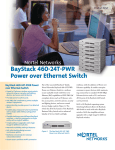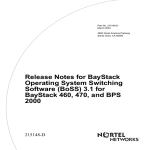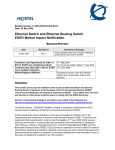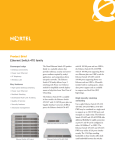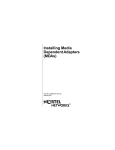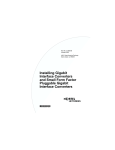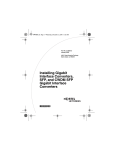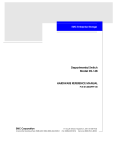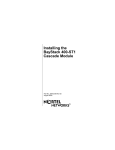Download Bay BayStack 400-ST1 Specifications
Transcript
Product Brief Nortel Networks BayStack 460-24T-PWR Power over Ethernet Switch BayStack 460-24T-PWR Power over Ethernet Switch • Power to IP phones, wireless access points, net cameras, security and lighting devices, and access control devices • Provides power to all 24 ports • IEEE P802.3af draft-compliant to power multiple vendors’ equipment • Automatically provides power to a detected device • Enables data and power to be transmitted over a single cable without using power outlets • Network availability with QoS features Part of the successful BayStack* family, Nortel Networks BayStack 460-24T-PWR Power over Ethernet Switch is a resilient, secure stackable switch with Power over Ethernet (PoE) capabilities to IEEE P802.3af draft-compliant devices such as IP phones, wireless access points, net cameras, security and lighting devices, and access control devices (badge readers) (Figure 1). The switch has all of the features of the BayStack Business Policy Switch such as advanced Quality of Service (QoS) and high-resiliency, with the addition of Power over Ethernet capability. It enables enterprise customers to power devices while maintaining connectivity to standard 10/100 Mbps Ethernet devices such as • Fail-safe stacking design assures continuous uptime • Resilient connectivity for minimal network downtime • Secure access and data traffic protection • Simplifies the process of making adds, moves, and changes Figure 1: The BayStack 460-24T-PWR Power over Ethernet Switch PCs and servers. All 24 ports of the BayStack 460 Switch can be powered. High-density Power over Ethernet switch The BayStack 460-24T-PWR Switch has 24 10/100 Mbps ports, one MDA (Media Dependent Adapter) slot for uplink connectivity, and one cascade module slot for stacking. Up to eight switches can be stacked to achieve up to 224 10/100 ports (using 4-port 10/100 Mbps MDA per switch). The 2.5 Gbps cascading bandwidth offers dedicated bandwidth between switches without sacrificing any uplink ports. The uplink ports can be used for connections to backbone switches such as the Passport 8600 Switch. IEEE P802.3af draft-compliant The BayStack 460-24T-PWR Switch is IEEE P802.3af draft-compliant. It can provide Power over Ethernet to any IEEE P802.3af draft-compliant devices such as IP phones, wireless access points, net cameras, security and lighting devices, and access control devices. The benefit of being interoperable with standards-based equipment means that customers are not forced to tie themselves to any one vendor, as the switch has the flexibility to power multiple vendors’ devices. It can supply power up to 15.4 watts per port, which meets the IEEE P802.3af standard. This is more than sufficient to power most devices. The standard is expected to be ratified in Q3, 2003. Auto discovery feature The BayStack 460-24T-PWR Switch automatically recognizes the connection of a device and immediately sends power to it. This automatic capability ensures fast connectivity without manual intervention. Dynamic power management Each port can be configured to limit the power delivered to a device. Each port can also be configured for power priority level— Figure 2: In the unlikely event of a switch failure, the stack integrity is maintained: cascade signals loop back at point of failure. Unit 8 Unit 7 Unit 6 Unit 5 Unit 4 Unit 3 Unit 2 Unit 1 2 Figure 3: Distributed MultiLink Trunking across stack for higher bandwidth and fault tolerance BayStack 460-24T-PWR Switch Stack Multi-Gigabit load-balancing and failover protection for uninterrupted access to the network center Passport 8600 Switch Server Low, High, and Critical. On the switch, total available power is monitored. In the case where all available power is fully utilized, the switch may turn off lower priority ports and turn on higher priority ports. Active circuit protection The BayStack 460 Switch can automatically disable a port if there is a short. All the other ports on the switch will remain active and will not be affected by the disabled port. Plug-n-Play IP telephony switching The BayStack 460 Switch provides simplified Web-based configurations on data and power properties. The graphical user interfaces make it simple to set up data and power configurations. Convenience of a single cable With the BayStack 460 Switch, data and power can be transmitted over one cable without using a power outlet. There is no need for a separate cable connecting the IP device to a power outlet. Significant space and cost savings Traditionally, a mid-span patch panel device connects to a standard Ethernet switch and the device sends power over standard UTP cat 5 cable. In essence, two units are needed for Power over Ethernet capability. In contrast, the BayStack 460 Switch integrates standard LAN switch functionality with the power over UTP cable capability of a mid-span patch panel into one unit. This results in significant cost and space savings. Fail-safe stacking and resiliency A key differentiation for the BayStack 460 Switch is its resilient stacking feature. The BayStack 460 Switch can stack up to eight units with a cascade stacking design, assuring continuous uptime even if a switch in the stack should fail. A loop-back—or redundant cascade cable—is used to seamlessly connect the entire stack to eliminate any single point of failure (Figure 2). MultiLink Trunking MultiLink Trunking (MLT) enables grouping of links between the switch and another switch or a server to provide greater bandwidth with active redundant links. With Nortel Networks unique Distributed MultiLink Trunking (DMLT) feature, trunked ports can span multiple units of the stack for fail-safe connectivity to missioncritical servers and the network center (Figure 3). This can provide bandwidth of up to 800 Mbps (when used with 10/100 ports) or up to 8 Gbps (when used with Gigabit uplink ports) with active redundant links in one trunk. Up to six trunks are supported per switch or stack. Split MultiLink Trunking (SMLT) eliminates single points of failure and allows wiring closet switches, such as the BayStack 460, to have multiple active connections to the network core. The BayStack 460 Switch’s ability to have multiple connections to a Passport 8600 network core allows customers to double network bandwidth with no extra investment. The Passport 8600 provides a self-healing network which delivers the reliability and availability required by today’s mission-critical applications. By combining the reliability of the Passport 8600 with the resilient trunking features of the BayStack 460 (DMLT, MLT, etc.), Nortel Networks offers the next generation of flexible networking solutions (Figure 4). Common software platform Stackable with the BayStack 450 Switch, BayStack Business Policy Switch and BayStack 470 Switch* End-to-end Voice over IP The BayStack 460 Switch can be stacked with the BayStack 450 Switches, BayStack Business Policy Switches, and BayStack 470 Switches.† A maximum of eight switches can be stacked together in any combination. All BayStack switches, including the BayStack 460 Switch, have a common “look and feel” which reduces training costs. This allows the switches to be managed in a similar fashion via a broad set of management tools. These tools include Web, Command Line Interface (CLI), menus, Optivity Network Management System (NMS), Optivity Switch Manager (OSM), and Optivity Policy Services (OPS). The BayStack 460 Switch provides enterprises another option for end-to-end deployment of Voice over IP. Succession Communication Server for Enterprise 1000, Business Communications Manager, Meridian, and BayStack all provide the choices that allow enterprises—from small and medium businesses to large campus infrastructures— Figure 4: Split MultiLink Trunking (SMLT) BayStack 460-24T-PWR Switch Stack BayStack 460-24T-PWR Switch Stack to deploy the solution that is right for them and offers the flexibility to implement infrastructure changes at their own pace. Figure 5 depicts an example of a smallto mid-sized enterprise solution with the BayStack 460 Switch. Figure 6 shows an example of a large enterprise solution. MAC addresses BayStack 460 Switches support up to 16,000 MAC addresses per switch or stack for deployment of large-scale enterprise networks with many attached devices and workgroups, allowing for scalability and cost-effectiveness. VLAN support Up to 256 port-based VLANs can be established for each switch, to extend the broadcast domain and segment network traffic. The 256 VLANs can be spread among portbased, and MAC source address-based VLANs (maximum of 48 MAC source address-based VLANs). The 256 VLANs can be on a standalone switch or across a stack. Protocol-based VLANs allow switch ports to be assigned to a broadcast domain, based on the protocol information within the packet. These VLANs can localize broadcast traffic and assure that the specified protocol type packets are sent only to the protocol-based VLAN ports. Shared VLAN (SVL) and individual VLAN (IVL) learning is supported. With SVL support, all VLANs in the switch share the same forwarding database. IVL lets individual VLANs have separate forwarding databases within the switch. IVL allows the switch to handle duplicate MAC addresses if they are in different VLANs. All ports active IGMP snooping Interswitch Trunk Passport 8600 Switch Passport 8600 Switch The BayStack 460 Switch features IP MultiCast support by examining (‘snooping’) all IGMP traffic in hardware at line rate, and pruning unwanted data streams from affecting network or end-station performance. † Future software release. 3 Figure 5: Small to medium enterprise solution Business Communications Manager 400 BayStack 460 Stack Net camera Business Series Terminals 10/100 Mbps Power Standard LAN Power over Ethernet Servers Multiple spanning tree protocol groups The BayStack 460 Switch supports multiple spanning tree groups (STGs). It supports a maximum of eight STGs, either all in one standalone switch or across a stack consisting of several BayStack 460 Switches. Multiple STGs provide multiple data paths, which can be used for loadbalancing and redundancy. ASCII configuration file The BayStack 460 Switch can download a user-editable ASCII configuration file from a Trivial File Transfer Protocol (TFTP) server. The ASCII configuration file can be loaded automatically at boot time or on demand using the management systems (console menus or CLI). Once downloaded, the configuration file automatically configures the switch or stack according to the CLI commands in the file. This feature allows the flexibility of creating command configuration files that can be used on several switches or stacks with minor modifications. 4 Desktop users i2004 802.11 Wireless LAN Security The BayStack* 460 Switch features BaySecure, which allows authentication of all access, not only to the switches for management and configurations, but also access to the infrastructure through these switches. This software feature limits access to only network authorized and trusted users including full tracking of network connections. With BaySecure, network access is granted or denied by proper MAC address identification (maximum of 448). In addition, with the Distributed Access List Security feature, network access is granted or denied on a per port basis. The BayStack 460 Switch also provides Remote Authentication Dial-In User Service (RADIUS) for switch security management. IP Manager List limits access to the management features of the BayStack 460 Switch by a defined list of IP addresses, providing greater network security and manageability. SNMPv3 provides user authentication and data encryption for higher security. It also offers secure configuration and monitoring. For even greater security, the BayStack 460 Switch also supports the IEEE 802.1x standard (Extensible Authentication Protocol or EAP). EAP limits access to the network based on user credentials. A user needs to “log in” to the network using username/ password; the user database is maintained on the authentication server (not the switch). EAP prevents network connectivity without password authorization for added security and control in physically non-secure areas. For example, banks, trading rooms, or classroom training facilities could take advantage of this feature. EAP supports client access to the network and interoperates with Microsoft Windows XP. Web-based management Web-based management using a Web browser simplifies the task of managing the BayStack 460 Switch. This feature provides summary, configuration, fault, statistics, application, administration, and support pages for entire stack. Traffic classification and prioritization can be set via the Web-based QoS Wizard and advanced configuration tool. Real-time sampling provides up-to-date LED stats info for stacked units. The Web interface also allows for static configuration of numerous parameters of the device. Power sharing options The BayStack 460 Switch can be used in conjunction with the BayStack 10 PSU or NES (Network Energy Source) DC Power System from Invensys (www.intergynes.com) to create a load sharing, RPSU, or UPS solution. Load sharing The BayStack 460 Switch provides up to 200 watts to power the devices. With the addition of a BayStack 10 PSU, up to 235 watts of total power can be supplied to devices. A 2-pin cable is required to connect from the BayStack 460 to the BayStack 10 PSU. With the addition of NES DC power system, up to 370 watts of total power can be supplied to devices. BayStack 10 PSU. Using NES DC power system, up to 200 watts of power can be supplied to devices in case the power supply of the BayStack 460 fails. Uninterruptible power supply support Using a BayStack 10 PSU will provide up to 75 watts of power to be supplied to devices in case there is an electrical outage. Up to 15 minutes of battery life is provided (this will vary depending on the amount of modules installed on the BayStack 10). Using NES DC power system, up to 200 watts of power can be supplied to devices in case there is an electrical outage. With NES system, up to 8 hours of battery life is provided (this will vary depending on the amount of modules on the NES unit). Redundant power supply unit support Using a BayStack 10 PSU will provide up to 75 watts of power to be supplied to devices in case the power supply of the BayStack 460 fails. A 2-pin cable is required to connect from the BayStack 460 to the NES ordering information For more product information on NES DC power systems, please visit their Web site at: www.intergynes.com BayStack 460 Stack Figure 6: Large enterprise solution Passport 8600 Distributed MultiLink Trunking Servers Net camera 10/100 Mbps Succession CSE 1000 For information on how to purchase NES DC power system, please e-mail Invensys at: [email protected] or [email protected] Power Network management On-box management Network management begins with the device. The BayStack 460 Switch supports four groups of Remote Monitoring (RMON) on all ports and is SNMPv3 compliant. The SNMP agent software resides in the switch and uses the information it collects to provide management for all ports in the stack. In addition, the agent also provides the ability to set up policybased networks by supporting the Common Open Policy Support (COPS) protocol.† Configuration management The process of configuration begins with a single device, but finishes across multiple devices. Java Device Manager (JDM) is the single device configuration tool for those configuration functions that require communicating with a single device. JDM uses a common user interface and workflow that supports many Nortel Networks Ethernet Switches. This commonality allows the network manager to become familiar with one tool instead of multiple tools. Optivity Switch Manager (OSM) performs the configuration function across multiple devices. Configuration functions such as VLAN assignments, MultiLink Trunking (MLT), and Multicast are deployed across multiple Nortel Networks Ethernet Switches. The BayStack 460 Switch will be supported in OSM version 3.0 in future releases. † Future software release. Succession Media Gateway Analog Phones CallPilot 2.0 Desktop users i2004 802.11 Wireless LAN Standard LAN Power over Ethernet 5 Fault management and resolution With Optivity Network Management System (NMS), the network manager has quick access to the information required to manage and isolate all BayStack 460 networks events. Tools such as Physical Topology View inform the network manager how a particular event is affecting the physical connectivity within the network. End Node Locate provides the ability to locate a failing end node and, with one mouse click, have access to the RMON statistics for the failing Ethernet port supporting that end node. These solutions provide visual and statistical tools necessary to quickly resolve any network event or to manage performance in real-time. The BayStack 460 will be supported in NMS version 10.1 (future release). In the meantime, there will be an OIT (Optivity Integration Toolkit) file for the BayStack 460 which can be used with NMS 10.0. Quality of Service Quality of Service (QoS) is becoming increasingly necessary as more of an organization’s critical business runs over the network infrastructure. When you implement the BayStack 460 Switch QoS features in your network, you can utilize bandwidth more efficiently, optimizing your existing network resources and capabilities. If the network is congested or down, if sales people cannot submit orders, if e-mail and intranet traffic threatens online Web transactions, or if new applications like voice and video fail, your business could be negatively impacted. By classifying, prioritizing, policing, and marking LAN traffic, networks can offer reliable connectivity and required bandwidth for mission-critical applications like VoIP to specific groups and users, as well as to individual devices. 6 For each of these applications, advanced QoS features support Internet Engineering Task Force (IETF) standard DiffServ QoS architecture, packet classification based on the contents of packet header fields (voice, video, data), traffic policing, and remote sniffing. As a result, optimal network performance and reliability may be attained while realizing significant cost savings. Customized service type and flow-based administrations through traffic shaping and policing may also be established, providing an opportunity for customer-specific service offerings, which can be implemented to address-specific and unique customer requirements. Queuing function Quality of Service and policy management QoS provides the ability to read, alter, prioritize, and tag or mark IP traffic based upon information imbedded in Type of Service (ToS). Based on the IETF Committee’s industry standards, the BayStack 460 Switch provides the ability to prioritize traffic based upon the required level of service for a given transaction. This level of service can be marked in the embedded information inside each IP packet’s ToS field. DiffServ is based upon ToS field. The BayStack 460 Switch has applicationspecific integrated circuits (ASICs) to enable DiffServ Code points can be mapped to 802.1p. • ToS/DSCP marking The QoS policies can be configured via the BayStack 460 Switch built-in Web-based management tools to facilitate QoS; alternatively, Optivity Policy Services can be utilized for dynamic end-to-end enterprisewide policy and QoS management, which is facilitated through the Common Open Policy Support (COPS) protocol (future software release). • IP source address/destination address or subnets Quality of Service provisioning The BayStack 460 Switch provides network availability for mission-critical applications, devices, and users. This is done by classifying, prioritizing, and marking LAN IP traffic using up to eight hardware-based IP service class queues (on the Gigabit uplink ports) based on the following parameters: • TCP/UDP source/destination port/ port range • 802.1p priority bits • Ingress source port • IP protocol ID (e.g. TCP, UDP, IGMP) • EtherType (e.g. IP, IPX) • VLAN ID It also has the ability to read packets that have been marked from other devices such as the Passport 8600 Switch. Also, weighted round-robin prevents normal priority traffic from being starved by expedited traffic (on a per-packet basis). With Optivity Policy Services (OPS), policies can be created through a simple intuitive drag and drop workflow. OPS is the Policy Decision Point in a DiffServ QoS implementation. Using OPS, common policies can be created one time and simultaneously implemented across many BayStack 460 Switches through a single command instead of hours of filter configuration. Policies are easily managed and updated in the OPS GUI. • Simple intuitive policy creation • Re-use filter common filter sets • Network-wide view of policies currently being enforced • Avoid QoS provisioning errors • Centrally manage DSCP and 802.1p to queue mapping tables • Save time provisioning the network; thousands of CLI or Web transactions reduced to a few simple actions The BayStack 460 is planned to be supported in OPS version 3.1 (future release). Newer Gigabit Ethernet MDAs The BayStack 460 Switch supports the latest Gigabit MDAs. Each of these MDAs will support 8 output queues and support traffic shaping. The three MDAs are: • BPS2000-1GT 1-port 1000BASE-TX MDA • BPS2000-2GT 2-port 1000BASE-TX MDA • BPS2000-2GE 2-port Small Form Factor GBIC MDA With the dual-port small form factor GBIC MDA, you can plug up to two small form factor pluggable GBICs. There are three types of small form factor pluggable GBICs to choose from: • 1-port 1000BASE-SX Small Form Factor GBIC (LC connector) • 1-port 1000BASE-SX Small Form Factor GBIC (MT-RJ connector) • 1-port 1000BASE-LX Small Form Factor GBIC (LC connector) New CWDM small form factor pluggable GBICs can also be used with the two-port small form factor GBIC MDA. With CWDM, a customer can dramatically increase the bandwidth supported over a single fiber. Instead of 1 Gigabit per fiber connection with a CWDM GBIC, eight wavelengths can be supported per fiber. In other words, eight gigabits of traffic can be supported across one single mode fiber. There are eight different wavelength GBIC options for 40 km and eight different wavelength GBIC options for 70 km. Traffic Policing Traffic Policing enables provisioning of different levels of service by limiting traffic throughput at the ingress (incoming) port of the BayStack 460 Switch. For example, if a port is set to certain speeds such as 10 Mbps, all traffic under 10 Mbps on that port will pass and traffic that exceeds 10 Mbps on that same port is dropped. Service providers will find this especially useful to control bandwidth to their customers. Summary With more than 100 years in telecommunications, Nortel Networks is uniquely positioned to help your business reduce costs by combining voice and data into an integrated system. Why take a chance on a vendor that only understands part of the equation? Let us show you how the BayStack 460 Switch— along with other Nortel Networks products—can increase your profitability, streamline your business operations, increase productivity, and help you gain the competitive edge. IP traffic shaping IP traffic shaping offers the ability to smooth IP classified traffic from the Gigabit uplink ports of a single BayStack 460 Switch. While traffic policing is needed to provide different levels of service to data streams on the ingress ports, traffic shaping is needed to smooth the traffic on the uplink connection from BayStack 460 to the network core, yielding the most efficient bandwidth utilization. The primary customers for rate shaping are service providers or carrier customers that are selling Ethernet in place of traditional Frame Relay, ISDN, or ATM WAN access solutions, and providing end-to-end Ethernet service for simplicity. Some enterprise customers use traffic shaping as a mechanism to limit bandwidth without having to swap out physical interfaces, leaving them room to grow. 7 Technical specifications Table 1: BayStack 460-24T-PWR Power over Ethernet Switch technical specifications Performance specifications Switch fabric 2.56 Gbps Frame forward rate (64-byte packets) Up to 3.2 million packets per second (pps) maximum, learned unicast traffic Port forwarding/filtering performance For 10 Mbps: 14,880 pps maximum (64-byte packets) Address database size For 100 Mbps: 148,810 pps maximum 16,000 entries at line rate (32,000 entries without flooding) Addressing 48-bit MAC address Frame length 64 to 1518 bytes (IEEE 802.1Q Untagged) 64 to 1522 bytes (IEEE 802.1Q Tagged) Data rate 10Mbps Manchester encoded or 100 Mb/s 4B/5B encoded Interface options 10BASE-T/100BASE-TX RJ-45 (8-pin modular) connectors for MDI-X interface 100BASE-FX SC and MT-RJ connectors for switched 100 Mbps (100BASE-FX) connections over 50/125 and 62.5/125 micron multimode fiber optic cable (2 km/6562 ft. maximum distance) 1000BASE-SX (Shortwave Gigabit Fiber) MDA SC connectors for shortwave 850 nm fiber optic connections over multimode 550 m/1805 ft.) fiber optic cable 1000BASE-LX (Longwave Gigabit Fiber) MDA SC connectors for longwave 1300 nm fiber optic connections over single-mode (3km/9843 ft.) or multimode (550m/1805 ft.) fiber optic cable The BayStack 450-1GBIC MDA supports the following GBICs: 1000BASE-SX Uses shortwave 850 nm fiber optic connectors to connect devices over multimode (550 m or 1,805 ft) fiber optic cable 1000BASE-LX Uses longwave 1,300 nm fiber optic connectors to connect devices over single mode (5 km or 3.1 mi) or multimode (550 m or 1,805 ft) fiber optic cable 1000BASE-XD Uses single mode fiber to connect devices over distances up to 40 km (or 31 mi), depending on the quality of the cable 1000BASE-ZX Uses single mode fiber to connect devices over distances up to 70 km (or 43 mi), depending on the quality of the cable. The ports on this GBIC operate only in full-duplex mode Network protocol and standards compatibility IEEE P802.3af draft-compliant IEEE 802.3 10BASE-T (ISO/IEC 8802 3,Clause 14) IEEE 802.3u 100BASE-TX (ISO/IEC 8802-3,Clause 25) IEEE 802.3u 100BASE-FX (ISO/IEC 8802-3,Clause 26) IEEE 802.1p (Prioritizing) IEEE 802.1Q (VLAN Tagging) IEEE 802.1z (Gigabit) IETF DiffServ RFC support RFC 1213 (MIB-II); RFC 1493 (Bridge MIB); RFC 2863 (Interfaces Group MIB) RFC 2665 (Ethernet MIB); RFC 2737 (Entity MIBv2); RFC 2819 (RMON MIB) RFC 1757 (RMON); RFC 1271 (RMON); RFC 1157 (SNMP); RFC 2748 (COPS) RFC 2940 (COPS Clients); RFC 3084 (COPS Provisioning); RFC 2570 (SNMPv3) RFC 2571 (SNMP Frameworks); RFC 2572 (SNMP Message Processing) RFC 2573 (SNMPv3 Applications); RFC 2574 (SNMPv3 USM); RFC 2575 (SNMPv3 VACM) 8 Technical Specifications Table 1: BayStack 460-24T-PWR Power over Ethernet Switch technical specifications (continued) Electrical specifications Input voltage: 100 to 240 VAC at 47 to 63 Hz Input power consumption: 400 W maximum Input volt amperes rating: 440 VA maximum Input current: 4.5 A @ 100 VAC, 2.25 A @ 240 VAC Maximum thermal rating: 575 BTU/hr Physical specifications Weight: 5.8 kg (12.76 lb) Height: 7.04 cm (2.77 in.) Width: 43.82 cm (17.25 in.) Depth: 38.35 cm (15.1 in.) Environmental specifications Operating temperature: 0° to 40° C (32° to 104°F) Storage temperature: –25° to 70° C (-13° to 158°F) Operating humidity: 85% maximum relative humidity, non-condensing Storage humidity: 95% maximum relative humidity, non-condensing Operating altitude: Up to 3024 m (10,000 ft.) Storage altitude: Up to 3024 m (10,000 ft.) Safety agency approvals UL listed (UL 60950) CUL (CAN/CSA-22.2 No. 60950) CB certificate and report with all national deviations (IEC 60950/EN60950) Electromagnetic emissions summary Meets the following standards: United States: FCC CFR47 PART 15, SUBPART B, Class A Canada: ICES-003, ISSUE-3, Class A Australia/New Zealand: AS/NZ 3548: 1995/A1:1997/A2; 1997, Class A Japan: VCCI-V-3/02.04/ Class A Taiwan: CNS 13438, Class A Europe: EN 55022-1998/A1:2000 Class A EMC Directive: 89/336/EEC: Directly published in the EMC Directive of 89/336/EEC with Modification 92/31/EED, 93/13/EC EN 61000-3-2: 2000 EN 61000-3-3: 1995/A1:2001 Global: CISPR 22-1997/A1:2000, Class A Electromagnetic immunity Global: CISPR 24:1997/A1:2001 Europe: EN55024:1998/A1:2001 9 Ordering information Table 2: BayStack 460-24T-PWR Power over Ethernet Switch ordering information Order No. AL2001x20** AL2033011 AL2033012 AL2033013 AL2033010 AL2018001 AL2018002 AL2018004 AL2033005^ AL2033006^ AL2033007^ AL2033008^ AL2033009^ AA1419001~ AA1419002~ AA1419003~ AA1419004~ AL2033014*** AL2033015*** AL2033016*** AA1419013 AA1419014 AA1419015 AA1419025 AA1419026 AA1419027 AA1419028 AA1419029 AA1419030 AA1419031 AA1419032 AA1419033 AA1419034 AA1419035 AA1419036 AA1419037 AA1419038 AA1419039 AA1419040 AA1419001 AA1419002 AA1419003 AA1419004 AL2018008 DY4311015 Description BayStack 460-24T-PWR Power over Ethernet Switch (24 10/100BASE-TX plus 1 MDA slot and 1 cascade module slot). BPS2000-4TX 4-port 10/100 MDA BPS2000-4FX 4-port 100BASE-FX MDA w/mini MT-RJ-type connectors BPS2000-2FX 2-port 100BASE-FX MDA w/SC-type connectors BayStack 400-ST1 Cascade Module (includes cascade cable) BayStack 400-SRC Cascade Return Cable (1 meter) BayStack 400-SSC Spare Cascade Cable (18 inch) BayStack 400-SRC Cascade Return Cable (3 meter) BayStack 450-1SX 1-port 1000BASE-SX Single PHY MDA BayStack 450-1SR 1-port 1000BASE-SX Redundant PHY MDA BayStack 450-1LX 1-port 1000BASE-LX Single PHY MDA BayStack 450-1LR 1-port 1000Base-LX Redundant PHY MDA BayStack 450-1GBIC MDA (GBIC not included with MDA) 1-port 1000BASE-SX Gigabit Interface Connector (GBIC), SC connector 1-port 1000BASE-LX Gigabit Interface Connector (GBIC), SC connector 1-port 1000BASE-XD Gigabit Interface Connector (GBIC)-40km SC connector 1-port 1000BASE-ZX Gigabit Interface Connector (GBIC)-70km SC connector BPS2000-1GT 1-port 1000BASE-TX MDA BPS2000-2GT 2-port 1000BASE-TX MDA BPS2000-2GE 2-port Small Form Factor GBIC MDA (supports up to two Small Form Factor GBICs) 1-port 1000BASE-SX Small Form Factor GBIC (LC connector) 1-port 1000BASE-SX Small Form Factor GBIC (MT-RJ connector) 1-port 1000BASE-LX Small Form Factor GBIC (LC connector) 1-port 1000BASE-CWDM Small Form Factor GBIC—1470nm Wavelength (40km), LC connector 1-port 1000BASE-CWDM Small Form Factor GBIC—1490nm Wavelength (40km), LC connector 1-port 1000BASE-CWDM Small Form Factor GBIC—1510nm Wavelength (40km), LC connector 1-port 1000BASE-CWDM Small Form Factor GBIC—1530nm Wavelength (40km), LC connector 1-port 1000BASE-CWDM Small Form Factor GBIC—1550nm Wavelength (40km), LC connector 1-port 1000BASE-CWDM Small Form Factor GBIC—1570nm Wavelength (40km), LC connector 1-port 1000BASE-CWDM Small Form Factor GBIC—1590nm Wavelength (40km), LC connector 1-port 1000BASE-CWDM Small Form Factor GBIC—1610nm Wavelength (40km), LC connector 1-port 1000BASE-CWDM Small Form Factor GBIC—1470nm Wavelength (70km), LC connector 1-port 1000BASE-CWDM Small Form Factor GBIC—1490nm Wavelength (70km), LC connector 1-port 1000BASE-CWDM Small Form Factor GBIC—1510nm Wavelength (70km), LC connector 1-port 1000BASE-CWDM Small Form Factor GBIC—1530nm Wavelength (70km), LC connector 1-port 1000BASE-CWDM Small Form Factor GBIC—1550nm Wavelength (70km), LC connector 1-port 1000BASE-CWDM Small Form Factor GBIC—1570nm Wavelength (70km), LC connector 1-port 1000BASE-CWDM Small Form Factor GBIC—1590nm Wavelength (70km), LC connector 1-port 1000BASE-CWDM Small Form Factor GBIC—1610nm Wavelength (70km), LC connector 1-port 1000BASE-SX Gigabit Interface Connector (GBIC), SC connector 1-port 1000BASE-LX Gigabit Interface Connector (GBIC), SC connector 1-port 1000BASE-XD Gigabit Interface Connector (GBIC)-40km SC connector 1-port 1000BASE-ZX Gigabit Interface Connector (GBIC)-70km SC connector 2-pin cable from BayStack 460-24T-PWR to BayStack 10 PSU (for RPSU and load-sharing capability) Power splitters for i200X phones—bag of 12 * These features will be supported on future software releases available free from the Web. ** The seventh character (x) of the switch order number must be replaced with the proper code to indicate desired product nationalization: “A” – No power cord included “B” – Includes European “Schuko” power cord common in Austria, Belgium, Finland, France, Germany, The Netherlands, Norway, and Sweden “C” – Includes power cord commonly used in the United Kingdom and Ireland “D” – Includes power cord commonly used in Japan “E” – Includes North American power cord “F” – Includes Australian power cord, also commonly used in New Zealand and the People’s Republic of China ^ Supports two output (egress) queues ~ One of these GBICs can be installed in the BayStack 450-1GBIC MDA ***Supports up to eight output (egress) queues 10 In the United States: Nortel Networks 35 Davis Drive Research Triangle Park, NC 27709 USA In Canada: Nortel Networks 8200 Dixie Road, Suite 100 Brampton, Ontario L6T 5P6 Canada In Caribbean and Latin America: Nortel Networks 1500 Concorde Terrace Sunrise, FL 33323 USA In Europe: Nortel Networks Maidenhead Office Park Westacott Way Maidenhead Berkshire SL6 3QH UK In Asia: Nortel Networks Asia 6/F Cityplaza 4, Taikooshing, 12 Taikoo Wan Road, Hong Kong Nortel Networks is an industry leader and innovator focused on transforming how the world communicates and exchanges information. The company is supplying its service provider and enterprise customers with communications technology and infrastructure to enable value-added IP data, voice and multimedia services spanning Wireline, Wireless Networks, Enterprise Networks, and Optical Networks. As a global company, Nortel Networks does business in more than 150 countries. More information about Nortel Networks can be found on the Web at: www.nortelnetworks.com/baystack460 GSA Schedule GS-35F-0140L 1-888-GSA-NTEL For more information, contact your Nortel Networks representative, or call 1-800-4 NORTEL or 1-800-466-7835 from anywhere in North America. *Nortel Networks, the Nortel Networks logo, and the globemark design are trademarks of Nortel Networks. All other trademarks are the property of their owners Copyright © 2003 Nortel Networks. All rights reserved. Information in this document is subject to change without notice. Nortel Networks assumes no responsibility for any errors that may appear in this document. NN102540-021903











